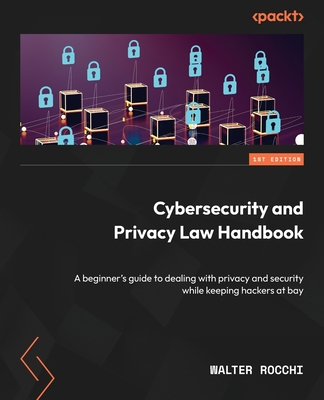Securing a Healthcare Facility: A Guide to Implementing a Comprehensive Cybersecurity Program for Small to Medium-Sized Facilities
暫譯: 醫療機構安全:中小型機構全面網路安全計畫實施指南
Sliger, Derek
- 出版商: Productivity Press
- 出版日期: 2025-12-02
- 售價: $2,190
- 貴賓價: 9.5 折 $2,081
- 語言: 英文
- 頁數: 16
- 裝訂: Quality Paper - also called trade paper
- ISBN: 1041103905
- ISBN-13: 9781041103905
-
相關分類:
Penetration-test
海外代購書籍(需單獨結帳)
相關主題
商品描述
The need for this book arises from the growing cybersecurity challenges faced by small to medium-sized healthcare facilities, which often lack the resources, expertise, and dedicated staff to interpret and implement complex security regulations.
These facilities must comply with critical standards such as the Health Insurance Portability and Accountability Act (HIPAA) Security Rule, 405(d) Health Industry Cybersecurity Practices (HICP), and the National Institute of Standards and Technology (NIST) Cybersecurity Framework (CSF), yet understanding these frameworks can be overwhelming. Without clear guidance, hospitals risk data breaches, operational disruptions, and regulatory penalties that could impact patient safety and trust. Securing through simplified explanations, actionable checklists, and real-world applications, this book empowers small and medium-sized hospitals to strengthen their security posture, achieve compliance, and ensure continued safety and efficiency of patient care. The book brings together three essential entities (one regulatory, one practice, and one framework) - HIPAA Security Rule, 405(d) HICP, and the NIST CSF - to guide organizations in creating a comprehensive cybersecurity program.
商品描述(中文翻譯)
本書的需求源於中小型醫療機構面臨日益嚴峻的網絡安全挑戰,這些機構通常缺乏資源、專業知識和專門人員來解釋和實施複雜的安全法規。
這些機構必須遵守關鍵標準,例如健康保險可攜性與責任法案(Health Insurance Portability and Accountability Act, HIPAA)安全規則、405(d) 健康產業網絡安全實踐(Health Industry Cybersecurity Practices, HICP)以及國家標準與技術研究所(National Institute of Standards and Technology, NIST)網絡安全框架(Cybersecurity Framework, CSF),然而理解這些框架可能會讓人感到不知所措。若沒有明確的指導,醫院面臨數據洩露、運營中斷和可能影響病人安全與信任的法規罰款風險。本書通過簡化的解釋、可行的檢查清單和實際應用,幫助中小型醫院加強其安全姿態,實現合規,並確保病人護理的持續安全與效率。本書將三個重要實體(即一個法規、一個實踐和一個框架)結合在一起——HIPAA安全規則、405(d) HICP和NIST CSF——以指導組織建立全面的網絡安全計劃。
作者簡介
I am an Information Security professional with a unique and diverse background that spans high-stakes National Defense and complex healthcare environments. My journey began with the American Missile Command (AMC) and the Strategic Defense Command (SDC), where I had the privilege of serving in critical roles that honed my technical and strategic expertise. Working with these organizations demanded the highest levels of vigilance, precision, and commitment to safeguarding national assets. The security stakes in missile command and strategic defense are uncompromising, and these early experiences shaped my understanding of threat landscapes and defense mechanisms at their most fundamental level.
After over a decade in National Defense, I transitioned into the healthcare industry, where I later assumed the role of Chief Information Security Officer (CISO) for multiple healthcare organizations. As a CISO, I found that while the operational environments differed vastly, the mission of protecting sensitive information and critical infrastructure remained paramount. Healthcare, like defense, is a high-stakes field where breaches can lead to severe consequences, not only data loss but also risks to patient safety and trust. This sector demands a nuanced approach that balances security and compliance with the accessibility required in medical settings. My role has involved implementing robust cybersecurity frameworks to safeguard patient information and ensure regulatory compliance while supporting a seamless healthcare delivery experience.
Over the years, I have developed extensive expertise with several foundational cybersecurity frameworks and regulations that are critical to both healthcare and other industries. My experience with National Institute of Standards and Technology (NIST) 800-53 has been a cornerstone of my work, allowing me to establish security and privacy controls that align with best practices for protecting information systems. I am well versed in tailoring NIST 800-53 controls to fit diverse organizational contexts, ensuring that they are both effective and adaptable to emerging threats and compliance requirements.
In the healthcare sector, Health Insurance Portability and Accountability Act (HIPAA) Security has been a primary focus, driving my efforts to protect electronic Protected Health Information (ePHI). I have guided organizations in implementing HIPAA's administrative, physical, and technical safeguards, ensuring that they are both compliant and resilient against cyber threats. I am also deeply familiar with 405(d) Health Industry Cybersecurity Practices, a framework tailored specifically for healthcare that provides practical measures for managing cyber risks. By aligning healthcare organizations with 405(d), I have helped them address top threats like phishing, ransomware, insider threats, and the security of medical devices, thus fortifying their defenses against the unique challenges the industry faces.
Furthermore, I have been integrally involved with the NIST Cybersecurity Framework (CSF), a versatile, industry-agnostic framework that has allowed me to build structured, scalable cybersecurity programs. Using the CSF's five core functions (Identify, Protect, Detect, Respond, and Recover), I have successfully established risk management strategies that are both comprehensive and adaptable. The CSF has been instrumental in guiding organizations through Risk Analysis, incident response planning, and continuous improvement cycles, all while aligning with business objectives.
This blend of experience, from the high-stakes realm of National Defense to the highly regulated, sensitive world of healthcare, has given me a unique perspective on cybersecurity. I bring a disciplined approach to risk management, compliance, and incident response, coupled with a deep understanding of how to protect information assets without disrupting critical operations. My career has been dedicated to building resilient, adaptive cybersecurity programs that not only meet regulatory requirements but also foster a culture of security across organizations. I am committed to staying ahead of evolving threats, integrating innovative technologies, and ensuring that security efforts align seamlessly with each organization's mission and values.
作者簡介(中文翻譯)
我是一名資訊安全專業人士,擁有獨特且多元的背景,涵蓋高風險的國防和複雜的醫療環境。我的旅程始於美國導彈指揮部(AMC)和戰略防禦指揮部(SDC),在這些機構中,我有幸擔任關鍵角色,磨練了我的技術和戰略專業知識。與這些組織合作要求最高程度的警覺性、精確性和對保護國家資產的承諾。導彈指揮和戰略防禦的安全風險是毫不妥協的,這些早期經驗塑造了我對威脅環境和防禦機制的基本理解。
在國防工作超過十年後,我轉型進入醫療行業,並隨後擔任多家醫療機構的首席資訊安全官(CISO)。作為CISO,我發現雖然操作環境差異巨大,但保護敏感資訊和關鍵基礎設施的使命始終是最重要的。醫療行業與國防一樣,是一個高風險的領域,資料洩漏可能導致嚴重後果,不僅是資料損失,還可能影響病人的安全和信任。這個行業需要一種微妙的平衡方法,將安全性和合規性與醫療環境所需的可及性相結合。我的角色涉及實施強健的網路安全框架,以保護病人資訊並確保遵守法規,同時支持無縫的醫療服務體驗。
多年來,我在多個基礎網路安全框架和法規方面積累了豐富的專業知識,這些對醫療和其他行業至關重要。我對美國國家標準與技術研究所(NIST)800-53的經驗是我工作的基石,使我能夠建立與保護資訊系統最佳實踐相符的安全和隱私控制。我熟悉根據不同組織背景調整NIST 800-53控制,確保它們既有效又能適應新興威脅和合規要求。
在醫療行業中,健康保險可攜性與責任法案(HIPAA)安全是我的主要關注點,推動我努力保護電子受保護健康資訊(ePHI)。我指導組織實施HIPAA的行政、物理和技術保障,確保它們既合規又能抵禦網路威脅。我也對405(d)健康產業網路安全實踐非常熟悉,這是一個專為醫療行業量身定制的框架,提供管理網路風險的實用措施。通過將醫療機構與405(d)對齊,我幫助他們應對釣魚攻擊、勒索病毒、內部威脅和醫療設備安全等主要威脅,從而加強他們對行業獨特挑戰的防禦。
此外,我還深度參與了NIST網路安全框架(CSF),這是一個多功能的、行業無關的框架,使我能夠建立結構化、可擴展的網路安全計劃。利用CSF的五個核心功能(識別、保護、檢測、響應和恢復),我成功建立了既全面又靈活的風險管理策略。CSF在指導組織進行風險分析、事件響應計劃和持續改進循環方面發揮了重要作用,同時與業務目標保持一致。
這種從高風險的國防領域到高度監管、敏感的醫療世界的經驗融合,讓我對網路安全有了獨特的看法。我對風險管理、合規性和事件響應採取了嚴謹的方法,並深刻理解如何在不干擾關鍵操作的情況下保護資訊資產。我的職業生涯致力於建立韌性強、適應性強的網路安全計劃,不僅滿足法規要求,還在組織內部培養安全文化。我致力於保持對不斷演變的威脅的前瞻性,整合創新技術,並確保安全工作與每個組織的使命和價值觀無縫對接。































